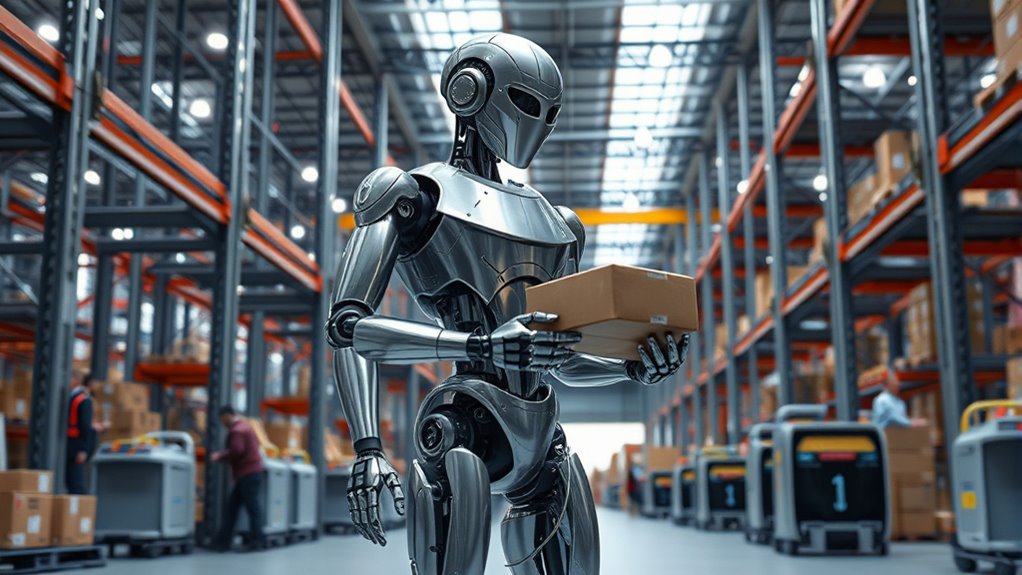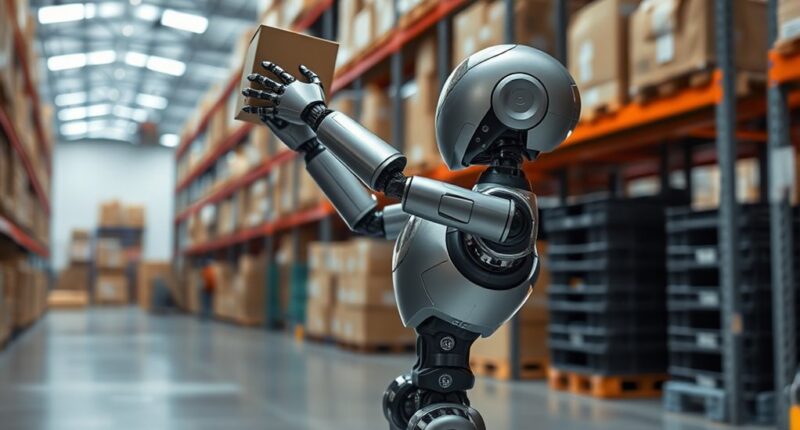Agility Robotics builds humanoid robots designed specifically for logistics, helping you improve efficiency by mimicking human movements. These robots can navigate complex and unpredictable environments, adapt quickly, and handle various objects with dexterity. Their advanced sensors and software give them real-time awareness, enabling autonomous navigation and precise task execution. As they refine their mobility and skills, you’ll see how they could become essential partners in transforming logistics operations—stick around to explore how they’re shaping the future.
Key Takeaways
- Agility Robotics develops humanoid robots capable of performing complex logistics tasks with human-like dexterity and precision.
- Their robots navigate diverse terrains using advanced sensors, cameras, and machine learning for obstacle avoidance.
- Designed for mobility and load carrying, they mimic human movements such as walking and stair climbing efficiently.
- Equipped with integrated sensors and software, they interpret visual data and recognize objects for autonomous operation.
- Ongoing advancements aim to enhance robotic dexterity, autonomy, and integration into logistics workflows for increased efficiency.

Have you ever wondered how robots are transforming the way we work and live? At the forefront of this revolution are humanoid robots developed by Agility Robotics, designed specifically to enhance logistics and automation. These robots are not just machines; they’re evolving tools capable of performing complex tasks that once required human intervention. Their robotic dexterity allows them to handle a variety of objects with precision, mimicking human movements to pick, place, and manipulate items efficiently. This level of dexterity means they can navigate cluttered environments, grasp fragile or oddly shaped objects, and work alongside human workers seamlessly, reducing errors and increasing productivity.
Humanoid robots by Agility Robotics enhance logistics with human-like dexterity and autonomous mobility.
One of the key innovations behind these robots is their ability to move through diverse terrains with autonomous navigation. Unlike traditional robots confined to structured factory floors, Agility Robotics’ creations can traverse dynamic and unpredictable environments. Through advanced sensors, cameras, and machine learning algorithms, these robots perceive their surroundings in real time, making decisions on the fly to avoid obstacles, find the most efficient routes, and adapt to new situations. This autonomous navigation capability is vital for tasks like warehouse management, last-mile delivery, or even disaster response, where flexibility and quick decision-making are essential.
As you observe these humanoid robots, you’ll notice how their design emphasizes mobility. They are built to walk upright, climb stairs, and carry loads, mimicking human movement with remarkable fluidity. This mobility is made possible by sophisticated joint mechanisms and real-time control systems that coordinate their limbs with incredible precision. Their robotic dexterity isn’t just about strength; it’s about finesse—handling delicate packages, inserting items into tight spaces, or stacking goods in tight quarters. This combination of mobility and dexterity enables them to operate in environments designed for humans, making them versatile assets in logistics.
Moreover, these robots are equipped with an array of sensors and software that give them situational awareness. They can interpret visual data, recognize objects, and even read signs or labels, helping them perform tasks autonomously. Their autonomous navigation systems work hand-in-hand with robotic dexterity, allowing them to move confidently through complex settings while manipulating objects with care. As a result, they can work tirelessly, reducing the workload on human employees and transforming how logistics operations are carried out. Agility Robotics’ focus on combining mobility, dexterity, and autonomous navigation pushes the boundaries of what robots can do, making them indispensable partners in modern logistics. Additionally, ongoing advancements in robotic learning techniques continue to expand their capabilities and efficiency in real-world applications.
Frequently Asked Questions
How Do Humanoid Robots Navigate Complex Warehouse Environments?
You can navigate complex warehouse environments by relying on sensor integration and advanced navigation algorithms. Sensors like lidar, cameras, and depth sensors provide real-time data about your surroundings, helping you detect obstacles and map the space. Navigation algorithms process this data to plan efficient paths, avoid hazards, and adapt to changing conditions. This combination allows you to move smoothly and safely through busy, unpredictable environments.
What Safety Measures Are in Place for Human-Robot Interactions?
Imagine a safety net strong enough to catch a falling star—that’s how your safety is protected around robots. You’re safeguarded through sensor integration that detects your presence and emergency protocols that activate instantly if needed. These measures ensure seamless, secure human-robot interactions, preventing accidents and creating a safe environment. You can work confidently, knowing that every step is carefully monitored and protected for your safety.
How Long Can These Robots Operate on a Single Battery Charge?
You’ll find that these robots typically operate for about 4 to 8 hours on a single battery charge, depending on their tasks and energy efficiency. Their advanced battery technology maximizes battery life, so you can rely on them for extended periods without frequent recharging. To optimize performance, consider monitoring energy consumption and scheduling recharges during downtime, ensuring continuous operation while maintaining energy efficiency.
Can the Robots Adapt to Different Types of Logistics Tasks?
Think of these robots as chameleons in the logistics jungle. They excel in robot versatility and task adaptability, allowing you to deploy them across various tasks like package sorting, loading, or inventory management. With advanced sensors and flexible programming, you can easily reconfigure their functions to suit different environments. This adaptability guarantees they stay effective no matter what logistics challenge you face, making your operations smoother and more efficient.
What Is the Expected Lifespan of an Agility Robotics Humanoid Robot?
You can expect an Agility Robotics humanoid robot to last around 7 to 10 years with proper robot maintenance and regular software updates. To maximize lifespan, you should perform routine maintenance, keep the hardware in good condition, and update the software to guarantee peak performance and security. This proactive approach helps the robot adapt to new tasks and reduces wear and tear over time.
Conclusion
As you witness Agility Robotics’ advancements, remember Icarus’s daring flight—bold and full of potential yet fragile. Your journey with these humanoid robots holds the promise of transforming logistics, making daily tasks more efficient and humane. Embrace this leap into the future, knowing that, like Icarus, we must balance ambition with caution. Together, we’re shaping a new world—one where human ingenuity and robotic innovation soar side by side.








